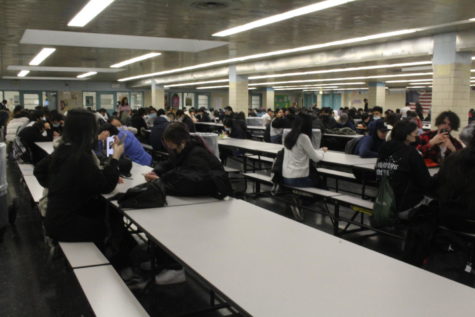TikTok Sets One Hour Screen Time for Teenagers
In early March, TikTok announced a brand new feature for users under the age of 18, a default 60 minute time limit. Concerned with students’ excessive amount of media usage, TikTok introduces the feature in order to help users stay in control of their screen time.
After a user’s daily 60 minutes have been reached on Tiktok, their notifications will be immediately muted to prevent them from further accessing the platform. However, TikTok has a second part of the feature that allows continuous usage of content. To access their account users will simply have to input a TikTok issued passcode in order to continue watching. However, the company hopes the feature can introduce students to a more healthy and productive use of their screen time and social media exposure.
While TikTok’s ultimate goal can be beneficial, users still have the choice to turn off the feature as they see fit but will continue to receive notifications if they exceed 100 minutes of daily TikTok usage. Nonetheless, with the power users under 18 still wield when concerning their social media usage, it raises doubts about the effectiveness of this new feature due to how simple it is to discard it.
Chief Executive of the Center for Countering Digital Hate, Imran Ahmed said that TikTok “is the crack cocaine of algorithms. It is the most addictive, it is the most dangerous and the one that needs to be dealt with most urgently.”
“Tiktok reminds me of the Pixar Disney animated movie, Wally,” librarian Ms. Vitiglio said. “In the movie humans now live on a giant spaceship where they sit in these floating hovercrafts. They’re all immensely overweight with a device that is held for them in front of them feeding them food, but also feeding their minds media of whatever it is they want them to know about.”
“That’s how I view TikTok, the app that’s like a magnet for students that curves your spine to sit and watch it on a tiny screen,” Ms. Vitiglio said. “It is an endless assembly line of sometimes meaningful, sometimes meaningless media, which makes me give TikTok a negative perspective.”
Showcasing the concept of the movie Wally in real life, English teacher Ms. Larson describes her personal experience dealing with students’ constant phone usage in their daily lives.
“I feel like TikToks are also addicting,” Ms. Larson said. “Students can’t disconnect themselves from their phones, they’re always checking their phone and it takes them a long time to disconnect. I always have to ask them to put the phones away, it’s a constant battle these days.”
Apart from being addicting, TikTok can also be harmful as Ahmed describes how a “13-year-old girl user was receiving eating disorder and self-harm content in her feed.” TikTok can not only be harmful to a child’s mental health but continues to engage them in time consuming content that could be spent elsewhere.
“I think that TikTok can be beneficial but more harmful to students because the information is nothing of real substance,” guidance secretary Ms. Karatzias said. “Students should be steered towards something more productive like schoolwork and spending time outside, which would be more important and more satisfying.”
On the other hand, TikTok said it is “introducing the feature to help people stay in control of their use” of the platform, acting as a reminder of their screen time to keep them aware so that they can make the proper changes in their lifestyle.
“I think it can help in some way because it can remind you of how long you’ve been on the platform,” Francis Lewis student Emily Xu said. “Some people aren’t aware how long they’ve been scrolling, but it doesn’t really do much though as it’s more about self control and TikTok is very addicting.”
“I think the only reason they created this feature is because people are complaining about overspending their time on TikTok, but then that’s just their way of saying they are trying to do something but not doing anything at the same time,” Xu added.
Therefore, despite the goal of this feature, its efficiency relies on the individual student as it can easily be bypassed and ignored.
“It will impact only the students who are already resilient, have the ability to govern themselves and are self-disciplined,” Ms. Vitiglio said. “If those features are easily bypassed, it raises questions like why would anybody give in to the timer or the limit notification unless they themselves are aware that too much time on TikTok is time wasted that you could be doing something in the real world and interacting with another human, not on the virtual plane.”
Even students are aware of challenges present when it comes to disconnecting from their devices which is an essential aspect of making this feature operational and beneficial towards addressing the overconsumption of social media.
“The effectiveness of this feature all depends on how it’s used,” junior Byrant Hernandez said. “For example, if you ask a friend to make your password and you don’t know the password, it can be very beneficial because you can’t use the app and the only way to get that password is by asking that friend. If there’s someone that’s just going to take advantage and make their own password and end up going beyond the limit of the initial hour you’re supposed to be on the app, I feel like then there’s no use for that.”
Nonetheless, apart from an individual’s inability to control their screen time, technology itself makes it essentially more difficult and challenging, especially to students.
“iPhones, YouTube, the apps on it are designed to break down your self-discipline so you are constantly feeling the need to reach for your phone,” Ms. Vitiligo said. “The cell phone and apps are a money maker and they want you to be addicted to your phone to give them more revenue.”
“While some adults are able to withstand that, it has become increasingly more difficult for them to do so,” Ms. Vitiligo said. “For young people it’s even harder because you have five year olds, six year olds after the pandemic now have devices in their hands because of remote learning and are even more addicted to it.”
However, regardless of the operational difficulties that can arise with this feature, the initial idea of one hour of TikTok for users can help teenagers and young adults feel more confident and less judged about their body image and appearance according to Helen Thai, a doctoral student in psychology at McGill University.
Therefore, in order to make this feature more efficient, TikTok should create a 10 minute deactivation after the 60 minute time is up. This would allow students to actually take a break from TikTok and focus on other more productive things, disengaging them from the platform completely. The current proposal states that kids could simply type in their password and continue watching, which is something they can easily bypass and get lost in.
By adding a more restrictive and a total social media disconnection aspect to the proposed feature it would actually allow students to improve their screen time and social media usage, accomplishing TikTok’s initial goal.
Hi, my name is Kathrine Yusupov and I first joined journalism in 2022 as a sophomore. After being managing editor in the 2023-2024 school year, I look...







